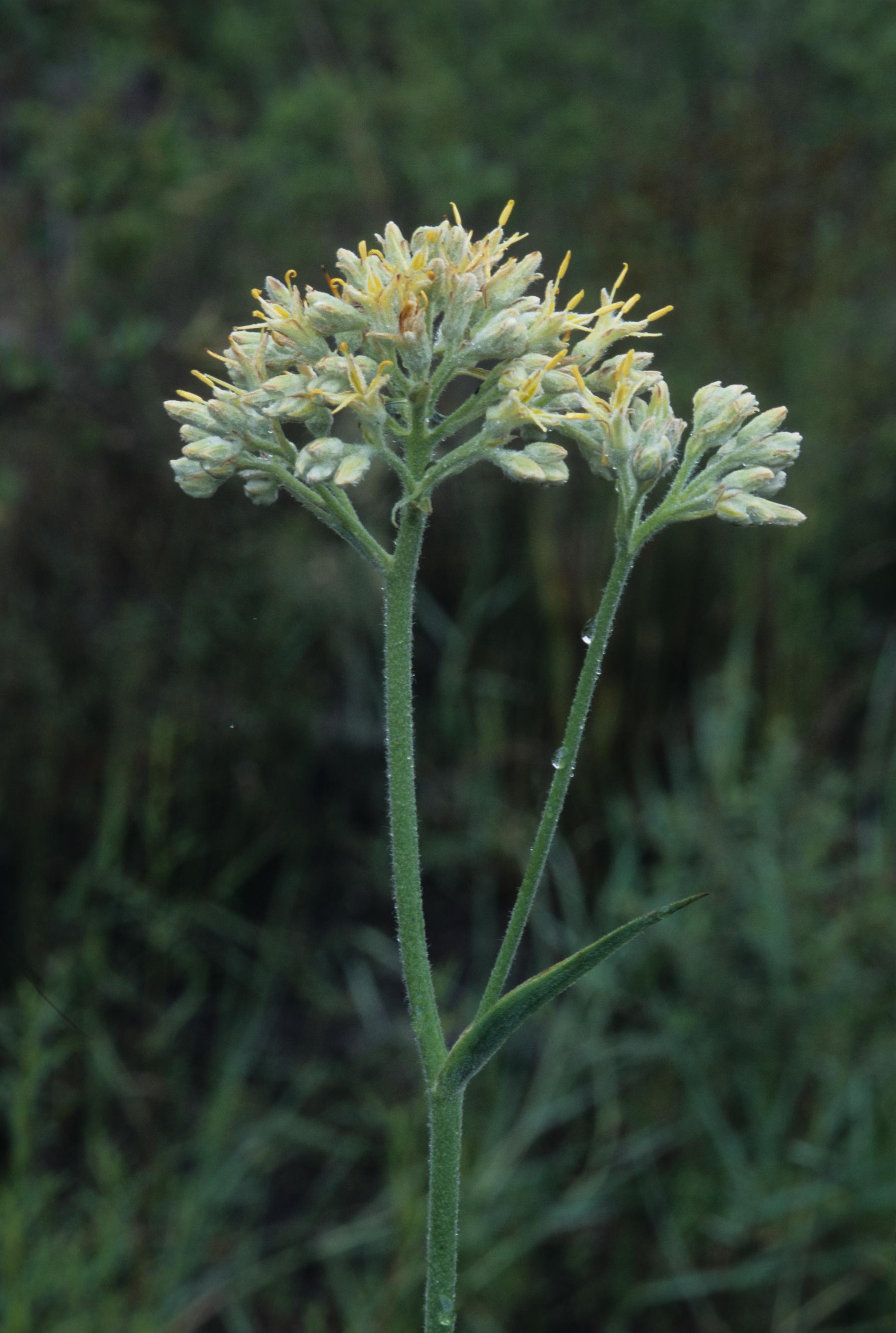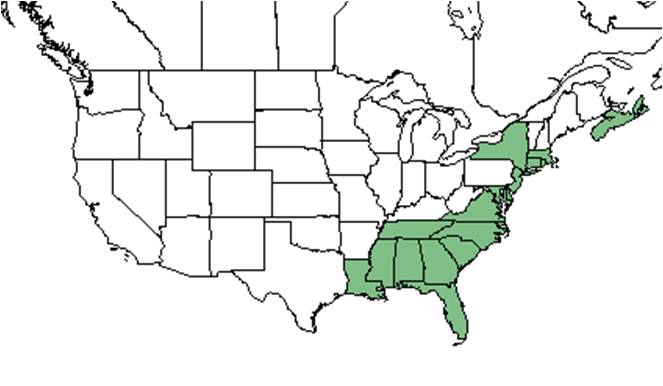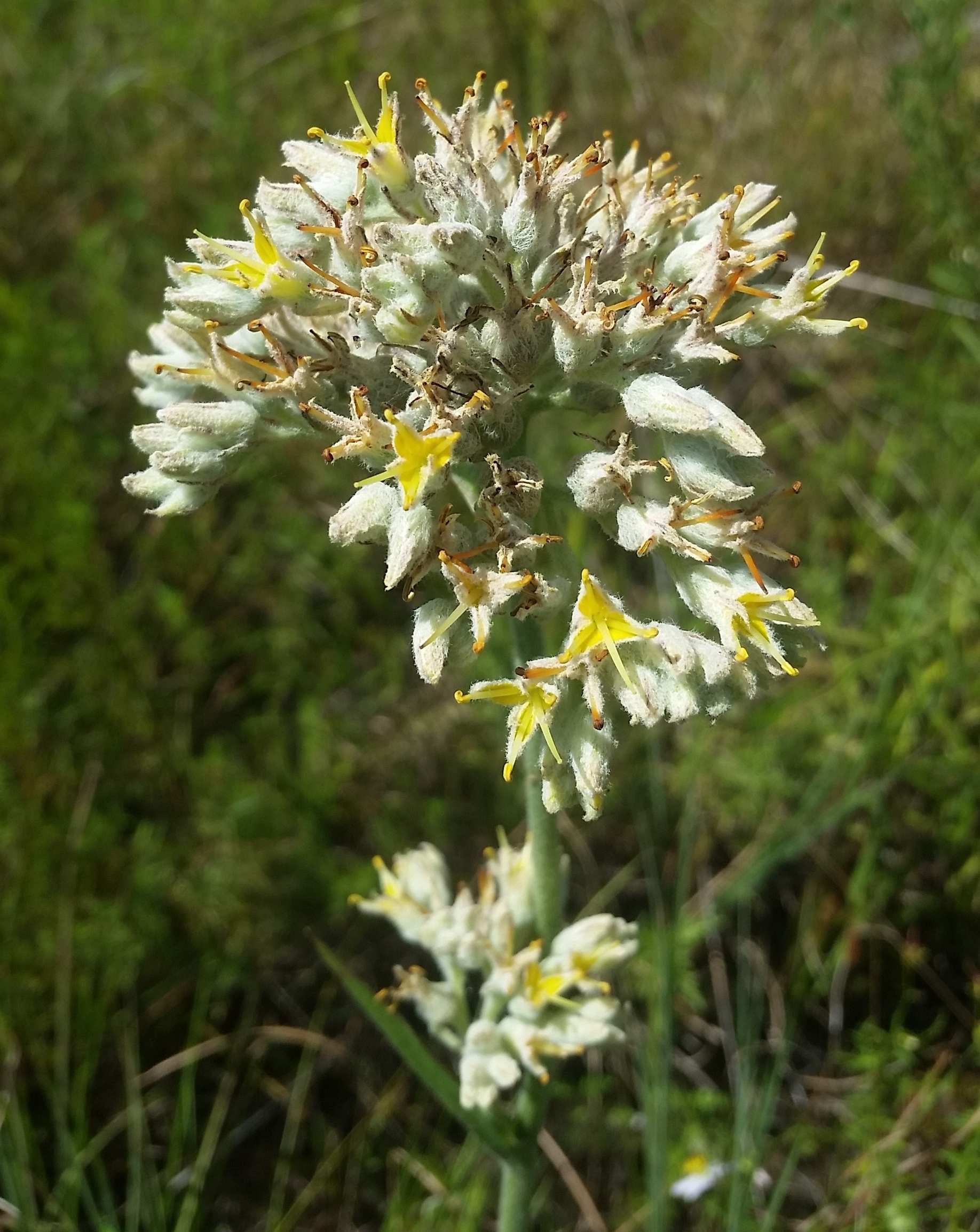Difference between revisions of "Lachnanthes caroliniana"
(→Description) |
|||
| Line 23: | Line 23: | ||
<!-- Basic life history facts such as annual/perrenial, monoecious/dioecious, root morphology, seed type, etc. --> | <!-- Basic life history facts such as annual/perrenial, monoecious/dioecious, root morphology, seed type, etc. --> | ||
''L. caroliniana'' is a perennial monocot with slender rhizomes and notable red roots. The flower stalk can reach up to three feet tall and has gray hairs along the top <ref name="dep">[[http://www.dep.state.fl.us/water/wetlands/delineation/featuredplants/redroot.htm]]Florida Department of Environmental Protection Accessed: January 9, 2016</ref>. | ''L. caroliniana'' is a perennial monocot with slender rhizomes and notable red roots. The flower stalk can reach up to three feet tall and has gray hairs along the top <ref name="dep">[[http://www.dep.state.fl.us/water/wetlands/delineation/featuredplants/redroot.htm]]Florida Department of Environmental Protection Accessed: January 9, 2016</ref>. | ||
| + | |||
| + | "Roots and rhizomes red. Stems pubescent only toward the inflorescence, glabrous below. Leaves 0.5-1.5 cm wide. Inflorescence convex. At first very compact and appearing head-like, expanding and become slightly open, the branches corymbosely arranged, each forming a compact helicoids cyme. Sepals 4-7 mm long, less than 1 mm wide, yellowish to brownish; petals 7-9 mm long, 1-1.5 mm wide, erect or slightly bent outward in age; stamens 3, exserted 1-2 mm, anthers at first straight, curling in age; styles slightly longer than the stamens; ovary inferior. Capsule oblate, 2-5 mm long, dehiscent to base. Seeds blackish brown, circular, 2-2.5 mm in diam., flat, surface uneven." - Radford et al 1964 | ||
==Distribution== | ==Distribution== | ||
Revision as of 20:22, 3 February 2016
| Lachnanthes caroliniana | |
|---|---|

| |
| Photo taken by Gil Nelson | |
| Scientific classification | |
| Kingdom: | Plantae |
| Division: | Magnoliophyta - Flowering plants |
| Class: | Liliopsida – Monocotyledons |
| Order: | Liliales |
| Family: | Haemodoraceae |
| Genus: | Lachnanthes |
| Species: | L. caroliniana |
| Binomial name | |
| Lachnanthes caroliniana (Lam.) Dandy | |

| |
| Natural range of Lachnanthes caroliniana from USDA NRCS Plants Database. | |
Common name: Carolina redroot
Contents
Taxonomic notes
Description
L. caroliniana is a perennial monocot with slender rhizomes and notable red roots. The flower stalk can reach up to three feet tall and has gray hairs along the top [1].
"Roots and rhizomes red. Stems pubescent only toward the inflorescence, glabrous below. Leaves 0.5-1.5 cm wide. Inflorescence convex. At first very compact and appearing head-like, expanding and become slightly open, the branches corymbosely arranged, each forming a compact helicoids cyme. Sepals 4-7 mm long, less than 1 mm wide, yellowish to brownish; petals 7-9 mm long, 1-1.5 mm wide, erect or slightly bent outward in age; stamens 3, exserted 1-2 mm, anthers at first straight, curling in age; styles slightly longer than the stamens; ovary inferior. Capsule oblate, 2-5 mm long, dehiscent to base. Seeds blackish brown, circular, 2-2.5 mm in diam., flat, surface uneven." - Radford et al 1964
Distribution
It can be found in coastal environments from Louisiana to Florida and north to Massachusetts, with disjunct populations in Tennessee, Virginia, and southern Novia Scotia, and can also be found in Cuba [2].
Ecology
Habitat
Habitats are typically wet, acidic, nutrient poor areas such as mesic and wet flatwoods, wet prairies, and seasonally inundated shorelines [3]. It can commonly be found in disturbed areas such as trails, ditches, fire lanes, and has been observed by Jean Huffman to form dense stands following hog-rooting.
It can become a serious weed in cranberry bogs and newly established pastures [4][5].
Associated species include Panicum hemitomon, Hypericum edisonianum and Panicum abscissum (George and Menges 1999).
Phenology
The white flowers are perfect and actinomorphic with a homoclamydeous imbricate perianth, 3 basifixed stamens, and an inferior, globose, slightly 3-lobed ovary (Simpson 1988) and arranged in a corymb[4]. The seed is a reddish 3 lobed capsule[3].
Seed dispersal
Seeds are dispersed locally by gravity [3].
Seed bank and germination
In the southern part of its range, it is capable of producing a substantial seed bank [3]. In an ex situ germination experiment in the marsh banks of southern Georgia, it was found that seedling germination was significantly increased by adding nitrogen plus phosphorus to a moist environment (Gerritsen and Greening 1989).
Fire ecology
It has been observed growing in a pond pine/titi peat swamp that was burned by a lightning set wildfire four months previously (FSU Herbarium). Hinman and Brewer (2007) observed L. caroliniana to have a reduction of flowering stalk density following a fire. This study also showed a significant decline between initial and pre-fire census and a significant increase between the immediate and second post-fire census.
Pollination
The following Hymenoptera families and species were observed visiting flowers of Lachnanthes caroliniana at Archbold Biological Station (Deyrup 2015):
Apidae: Apis mellifera, Bombus impatiens, B. pennsylvanicus, Mellisodes communis
Halictidae: Agapostemon splendens, Augochloropsis metallica, A. sumptuosa, Lasioglossum coreopsis, L. nelumbonis
Megachilidae: Anthidiellum perplexum, Anthidium maculifrons, Coelioxys mexicana, C. octodentata, C. sayi, Megachile albitarsis, M. brevis pseudobrevis, M. georgica, M. mendica, M. petulans, M. texana
Sphecidae: Philanthus ventilabris
Vespidae: Polistes bellicosus, P. fuscatus
Use by animals
L. caroliniana is an important food source to wigeons, gadwalls, pintails, sandhill cranes and mallards, which eat the seeds and rhizomes (Landers et al. 1976). This species contains photodynamic toxins that limit herbivory by insects and some vertebrates but not waterfowl (Kornfeld and Edwards 1972).
Conservation and Management
Eutrophication from agriculture and urbanization has had a detrimental impact of Coastal Plain plant communities in Long Island and New Jersey (Zaremba and Lamont 1993).
In Nova Scotia, it is listed as a threatened species [2].
Cultivation and restoration
Historically, it was used by Native Americans as a narcotic and to treat ailments (Millspaugh 1887).
Photo Gallery
References and notes
Deyrup, M.A. and N.D. 2015. Database of observations of Hymenoptera visitations to flowers of plants on Archbold Biological Station, Florida, USA.
Florida State University Robert K. Godfrey Herbarium database. URL: http://herbarium.bio.fsu.edu. Last accessed: January 2016. Collectors: Loran C. Anderson, Kathleen Craddock Burks, R. Komarek, Thomas E. Miller, R.A. Norris, Cecil R. Slaughter, Rodie White. States and Counties: Florida: Duval, Lafayette, Osceola, Santa Rosa, St. Johns, St. Lucie, Volusia, Wakulla. Georgia: Grady. Compiled by Tall Timbers Research Station and Land Conservancy.
George, B. L. and E. S. Menges (1999). "Dynamics of Woody Bayhead Invasion into Seasonal Ponds in South Central Florida." Castanea 64(2): 130-137.
Gerritsen, J. and H.S. Greening. 1989. Marsh Seed Banks of the Okefenokee Swamp: . Floristic Synthesis of North America (CD-ROM, Draft). Biota of North America Program, Chapel Hill, NC.
Hinman, S. E. and J. S. Brewer (2007). "Responses of Two Frequently-Burned Wet Pine Savannas to an Extended Period without Fire." The Journal of the Torrey Botanical Society 134(4): 512-526.
Kornfeld, J.M. and Edwards, J.M. 1972. Investigation of photodynamic pigments in extracts of Lachnanthes tinctoria. Biochimica Et Biophysica Acta 286:88.
Landers, J. L., A. S. Johnson, et al. (1976). "Duck Foods in Managed Tidal Impoundments in South Carolina." The Journal of Wildlife Management 40(4): 721-728.
Millspaugh, C.F. 1887. American Medicinal Plants. Caxton Press of Sherman, Philadelphia.
Nichols, G.E. 1934. The influence of exposure to winter temperatures on seed germination in various native North American plants. Ecology 15:364-373.
Simpson, M. G. (1988). "Embryological Development of Lachnanthes caroliniana (Haemodoraceae)." American Journal of Botany 75(9): 1394-1408.
Zaremba, R.E. and E.E. Lamont. 1993. The status of the Coastal Plain Pondshore community in New York. Bulletin of the Torrey Botanical Club 120:180-187.
